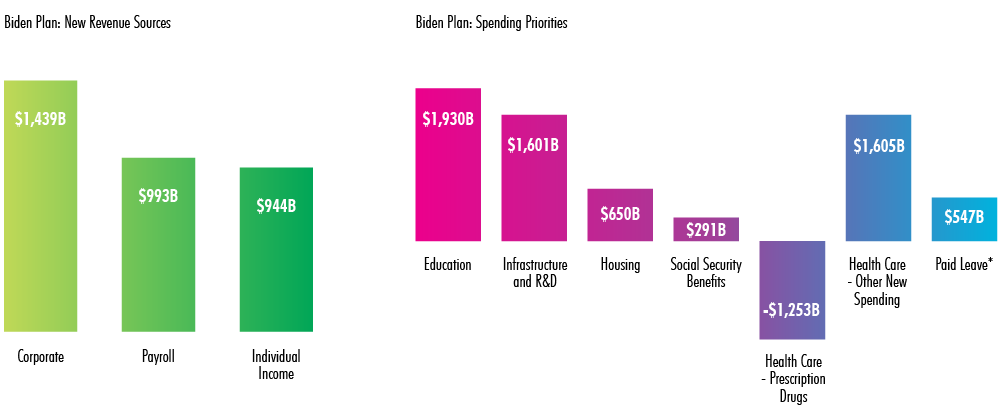Chapter 2
Election
U.S. Real Estate Market Outlook 2021
3 Minute Read
Biden Presidency / Democrat-Controlled Congress
President Biden's ability to fully implement his domestic agenda for increased spending and revenue (taxes) was greatly bolstered by Democrat control of Congress. The $1.9 trillion American Rescue Plan was enacted in March to further stimulate the economy. More large policy proposals are in the works, including a $2 trillion infrastructure package.
Overall, Biden’s platform calls for $5.4 trillion in additional spending over 10 years. If enacted, expanded health insurance coverage likely will drive demand for medical space situated closer to the consumer and spur the conversion of some retail space. In addition, increased investments in infrastructure and R&D should benefit office and industrial real estate demand. Housing policy initiatives—notably including tying federal funding to zoning changes to spur affordable housing development in suburban locales, as well as greater affordable housing subsidies—could present unique opportunities for residential real estate.
Biden has called for nearly $3.4 trillion in additional revenue over 10 years. This would be primarily achieved by partially repealing the 2017 tax cuts and further increasing income tax rates on those earning more than $400,000 per year, taxing capital gains as ordinary income for households with incomes over $1 million, additional payroll taxes and higher taxes on corporations. If implemented, the tax law changes could lower spending in the luxury retail segment and some areas of the housing market. An increase in corporate taxes may impact businesses’ capital expenditures and wage and job growth, but this could be offset in the medium term by a more stable global trade environment and a strong economic recovery. If pursued vigorously, Biden’s environmental agenda would have implications for commercial building operating costs to meet higher energy efficiency standards.
Figure 4: Overall Revenue And Spending Effects Of The Biden Platform, 2021-2030

*This estimate for Paid Leave comes from the CBO’s 2020 score of H.R. 1185, the FAMILY Act, which Biden’s paid leave plan is based on.
https://www.cbo.gov/system/files/2020-02/hr1185_2.pdf
Source: Penn Wharton Budget Model, University of Pennsylvania, September 2020.
Notes: For PWBM’s long-term macroeconomic modeling, all of Biden’s provisions for new spending on Education, Social Security Benefits and Health Care (Spending and Drugs) are assumed to continue past 2031. Some Housing Assistance provisions and all Infrastructure and R&D provisions end in 2031. Paid Leave is not incorporated into PWBM’s macroeconomic modeling.
The Democratic Senate will enable Biden to enact large portions of his agenda over the next two years. The recently enacted $1.9 trillion American Rescue Plan will boost real estate demand in the near term. This federal stimulus package has led CBRE to revise its forecast of 2021 GDP growth to 6.7% from 4.5%. More aid to state and local governments will reduce pressure to raise taxes on real estate. However, the popular 1031 tax-free exchange program could be threatened and luxury retail, energy, finance, defense contractors and tech could face headwinds from tax and spending policy changes and increased regulation.
If Republicans regain control of the Senate or House in the 2022 mid-term elections, the Biden agenda will be checked during the last half of his term and have a more subdued effect on the broader economy and commercial real estate. Even if this occurs, Biden will still have power to influence spending priorities and the regulatory environment, as well as to enact trade policy. The potential for less trade friction, especially with U.S. allies, may be helpful as the global economy pulls out of the pandemic-induced recession.
Looking ahead, the composition of Biden’s $2 trillion infrastructure investment proposal and how to pay for it will be key to understanding long-term policy impacts on real estate. On a cautionary note, geopolitical risks are rising. This can be seen in the buildup of Russian troops on the Ukrainian border, continuing trade frictions between China and the U.S. and tensions between China and Taiwan. These mean that Biden will be unable to give undivided attention to his domestic agenda.
Contacts
Spencer Levy
Global Client Strategist & Senior Economic Advisor, CBRE
.jpg)
Darin Mellott
Vice President, Head of U.S. Capital Markets Research, CBRE

